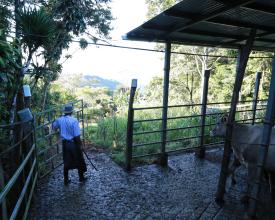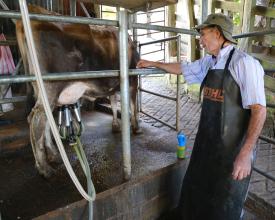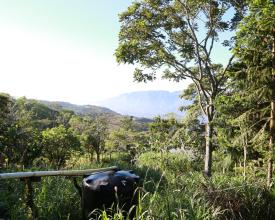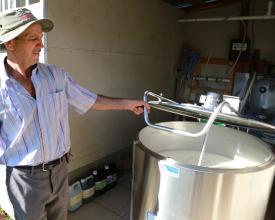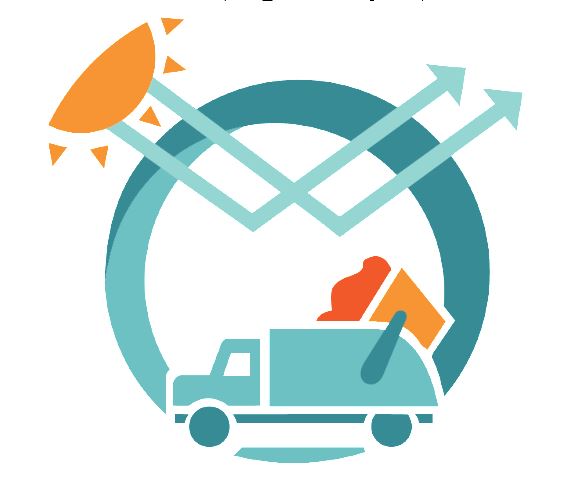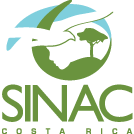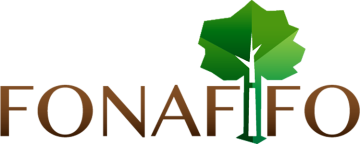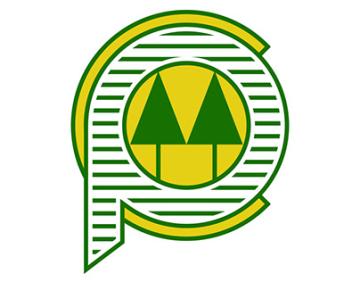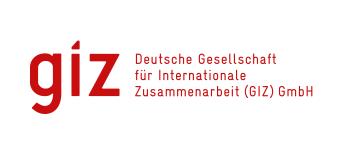
Integration of the Landscape Restoration Approach in the Dairy Value Chain
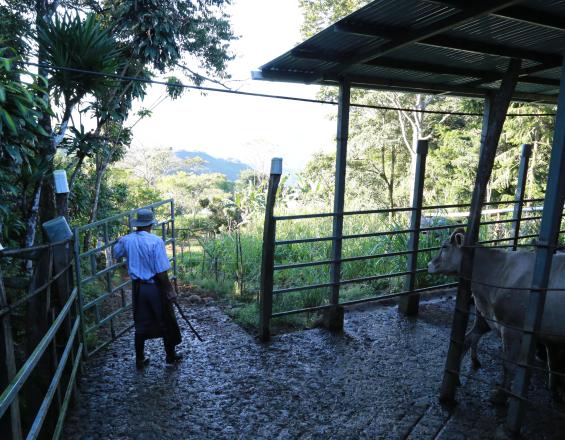
The cantons of Puriscal and Turrubares are degraded landscapes due to the advance of the agricultural frontier. Tobacco cultivation and extensive cattle ranching caused the loss of 60% of the forest cover in the area between the 1950s and 1980s; currently, dual-purpose cattle ranching (meat and milk) and agriculture (coffee, vegetables, sugar cane and ornamental plants) are the main economic activities in the area.
With this solution, a scheme was proposed to increase the supply of environmental goods and services in silvopastoral systems, incorporating: a) sustainable practices (introduction of improved pasture, safety and clean milking, irrigation systems and incorporation of the tree component in the productive units), and b) the combination of public (PES) and private (Credits) financing.
Context
Challenges addressed
- The area has critical soils with high levels of degradation, as well as a strong fragmentation of the forest in water recharge zones due to the pressure of agroindustrial crops in the area, cattle ranching and poor agricultural practices.
- The lack of technical and financial mechanisms to enable the transition from the most representative production system in the area (dual-purpose cattle ranching), which exerts the greatest pressure on natural resources, to a functional and sustainable silvopastoral system.
Location
Process
Summary of the process
The implementation of good silvopastoral practices (B1) by itself is functional at the farm level, bringing benefits to the individual who applies it, since it establishes the technical parameters to implement an optimal silvopastoral system, according to the characteristics of his productive unit.
Incorporating producers with good practices into a value chain (B2) increases the probability of maintaining good practices by linking them to the market. While linking producers to public and private financing programs (B3), allows injecting resources that facilitate sustainability, as well as the replication and scaling up of actions.
Finally B1 works as a training for the producer to be introduced to the minimum practices required by B2 and this prepares him for B3 and makes his restorative productive unit grow in a sustainable way.
Building Blocks
Implementation of Good Silvopastoral Practices
The objective of this building block is to provide livestock producers with the technical parameters to implement an optimal silvopastoral system, according to the characteristics of their productive unit and at the same time contributing to restore the ecosystem services of the site.
Good agricultural practices were implemented in three areas: 1) the animal and its management, which includes feeding, health and animal welfare; 2) environment and production, which includes soil, water and forage, as well as waste, manure and effluent management; and, 3) infrastructure for production, with facilities, equipment and tools for cleanliness and product safety.
Enabling factors
- To make producers aware of the benefits that the introduction of good silvopastoral practices can bring to their productive unit.
- Train livestock producers with relevant and current content, accompanied by high quality professionals, with experience and demonstrable results.
- Complement the training with technical tours, where the results of implemented measures can be observed, as well as testimonies of people who have benefited from the changes made.
Lesson learned
- It requires a high level of commitment from livestock producers, both in terms of technical preparation (participation in training and field tours), as well as in the improvement of the systems, compliance with plans and discipline in the continuity of actions while achieving the expected results.
- To achieve a commitment of the participants, the training process must be relevant and pedagogically stimulating; this requires a good planning of the process, focused mainly on the duration, as well as on the quality of the training process.
- All training material should be mediated and practice-oriented, so that the farmer can put it into practice without much difficulty.
Incorporating Good Practice Producers into a Value Chain
The objective of this building block is to provide continuity to the good practices implemented by livestock producers by incorporating them into value chains that value products from sustainable sources.
This can be achieved through the analysis of value chains that are linked to the sector in which the producer operates. In this case, a dairy value chain was linked, since this is where the greatest added value can be obtained for both the livestock producer and the Coopepuriscal R.L. Cooperative.
Another important aspect is to determine where the producer is in the chain (micro, meso or macro) and what type of activity he/she carries out (primary or support). In this case, the producer is at the micro level with a primary activity (delivering raw materials without much value added).
Enabling factors
- Find trading partners who are interested in quality products that demonstrate that they are environmentally friendly and have been produced with sustainable practices.
- Trading partners are willing to improve the quality of their supply chain with local producers.
Lesson learned
- Preferably there should be an organizational structure (cooperative, association, etc.) that will reduce transaction and intermediation costs for producers and allow them to receive better income.
- Agreements with commercial partners should incorporate, as far as possible, a stable demand for raw material, which will encourage livestock producers to invest in improving their production system.
Incorporation of Beneficiaries into Public and Private Financing Programs
The objective of this building block is to provide financing, either public (through payment for environmental services programs, forestry incentives, non-reimbursable cooperation projects) or private (commercial bank and second-tier bank loans), to livestock producers who carry out good practices and promote restoration.
In this case, the cooperative had proven experience in placing loans for housing solutions, productive loans and had accreditations that allowed it to function as a second-tier bank with a mobilization of USD $210,400.00 in agricultural loans; in addition, it had the FONAFIFO environmental services payment program where 13,635 trees were subjected to incentives under modalities of protection of springs and agroforestry systems.
Enabling factors
-
Identify a local, subnational or national partner with experience in credit placement within the selected value chain that can develop and prioritize credit lines, acceptance criteria, maximum disbursement amounts, generate competitive interest rates and reduce risk.
- Identify national programs linked to the value chain that encourage good practices or make payments for results.
Lesson learned
- In the case of private financing, it is important to provide technical support in the execution of the loan, since it allows the proper use of resources and ensures that the borrower achieves his goals.
- In the case of public financing, it is important to identify different elements of the productive system that can be subsidized by national programs, for example, equipment that reduces operating costs; business development programs that could reduce marketing costs, etc.
Impacts
- Restoration of 1,142.5 hectares in 35 productive units.
- Increased carbon stock by 1,009 tons, increased water infiltration by 23,444 mm, reduced erosion by 8.6% and increased the connectivity index by 0.02 points.
- Increased dairy processing capacity from 3,500 liters/day to 7,000 liters/day.
- Mobilization of USD $ 210,400.00 in agricultural credits with a 20% participation of women producers.
Beneficiaries
37 livestock producers (30 men and 07 women), with production units of 30 hectares and with the technical capacity to integrate into a value chain.
Sustainable Development Goals
Story
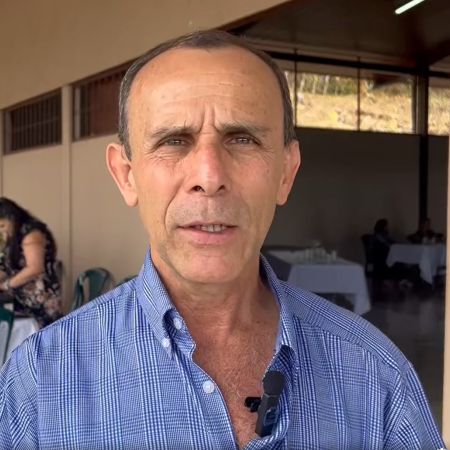
"The practices to give sustainability to production are fundamental. The cows need shade to produce milk. We have to adapt to the changes in the climate to be able to continue producing; in addition, all these practices will lead us to produce better quality milk both by improving the genetics and the feeding of the cows." Geovanny Sanchez, Manager of Coopepuriscal R.L.

